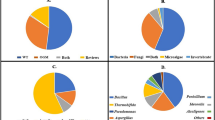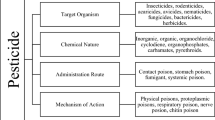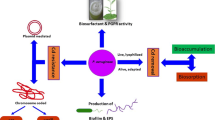Abstract
The massive use of pesticides represents one of the main causes of environmental deterioration, as they have adverse effects on non-target organisms. Thus, the development of technologies capable of reducing their release into the environment is urgently needed. This study reports for the first time the white-rot fungus Trametes versicolor as an alternative towards the degradation of medium to highly polar pesticides such as the organophosphate malathion, and the neonicotinoids acetamiprid and imidacloprid. Specifically, T. versicolor could completely remove 1 mg/L of malathion in an Erlenmeyer flask within 48 h, while experiments of acetamiprid and imidacloprid (4 mg/L), conducted in air-pulse fluidized bioreactors, resulted in degradation percentages of 20% and 64.7%, respectively, after 7 days of operation. Enzymatic exploration studies revealed that the cytochrome P450 system, instead of the extracellular enzyme laccase, is involved in the degradation of acetamiprid and imidacloprid. The degradation pathways were proposed based on the main transformation products (TPs) formed in the solutions: seven in the case of malathion, and two and one in the case of imidacloprid and acetamiprid, respectively. Although the TPs identified were predicted to be less toxic than the investigated pesticides, the toxicity of the individual solutions slightly increased throughout the degradation process, according to the Microtox assay. However, the solution toxicity was always below the threshold established in the local regulation. Although additional research is needed to implement this treatment at a pilot plant scale, this work highlights the potential of T. versicolor to bio-remediate pesticide-contaminated waters.
Graphical abstract




Similar content being viewed by others
References
Rogowska J, Cieszynska-Semenowicz M, Ratajczyk W, Wolska L. Micropollutants in treated wastewater. Ambio. 2020;49(2):487–503.
Rani L, Thapa K, Kanojia N, Sharma N, Singh S, Grewal AS, et al. An extensive review on the consequences of chemical pesticides on human health and environment. J Clean Prod. 2020;283:124657.
Carvalho FP. Pesticides, environment, and food safety. Food Energy Secur. 2017;6(2):48–60.
Anderson J, Dubetz C, Palace V. Neonicotinoids in the Canadian aquatic environment: a literature review on current use products with a focus on fate, exposure, and biological effects. Sci Total Environ. 2015;505:409–22.
Newhart K. Environmental fate of malathion. California Environmental Protection Agency. 2006:1–20.
Pimentel D, Burgess M. Small amounts of pesticides reaching target insects. Environ Dev Sustain. 2012;14:1–2.
Reed NR, Rubin AL. Malathion. In: Richardson RJ (3rd). Encyclopedia of toxicology. Amsterdam: Elsvier; 2014. pp. 133–137.
Fritschi L, McLaughlin J, Sergi C, Calaf G, Le Curieux F, Forastiere F, et al. Carcinogenicity of tetrachlorvinphos, parathion, malathion, diazinon, and glyphosate. Red. 2015;114(2):70134–8.
Jeschke P, Nauen R. Neonicotinoids-from zero to hero in insecticide chemistry. Pest Manag Sci. 2008;64(11):1084–98.
Bonmatin JM, Giorio C, Girolami V, Goulson D, Kreutzweiser D, Krupke C, et al. Environmental fate and exposure; neonicotinoids and fipronil. Environ Sci Pollut R. 2015;22(1):35–67.
Sánchez-Bayo F. The trouble with neonicotinoids. Science. 2014;346(6211):806–7.
Sheets LP. Imidacloprid. In: Richardson RJ (3rd). Encyclopedia of toxicology. Amsterdam: Elsvier; 2014. pp.1000–1003.
Wallace DR. Acetamiprid. In: Richardson RJ (3rd). Encyclopedia of toxicology. Amsterdam: Elsvier; 2014. pp.30–32.
Pesticides and bee toxicity. In: Minnesota Department of Agriculture. https://www.mda.state.mn.us/protecting/bmps/pollinators/beetoxicity. Accessed 7 Oct 2020.
Blacquiere T, Smagghe G, Van Gestel CA, Mommaerts V. Neonicotinoids in bees: a review on concentrations, side-effects and risk assessment. Ecotoxicology. 2012;21(4):973–92.
Mitchell EA, Mulhauser B, Mulot M, Mutabazi A, Glauser G, Aebi A. A worldwide survey of neonicotinoids in honey. Science. 2017;358(6359):109–11.
Nicholls CI, Altieri MA. Plant biodiversity enhances bees and other insect pollinators in agroecosystems. A review Agron Sustain Dev. 2013;33(2):257–74.
Megharaj M, Ramakrishnan B, Venkateswarlu K, Sethunathan N, Naidu R. Bioremediation approaches for organic pollutants: a critical perspective. Environ Int. 2011;37(8):1362–75.
Gao D, Du L, Yang J, Wu W, Liang H. A critical review of the application of white rot fungus to environmental pollution control. Crit Rev Biotechnol. 2010;30(1):70–7.
Ganash M, Abdel Ghany T, Reyad A. Pleurotus ostreatus as a biodegradator for organophosphorus insecticide malathion. J Environ Anal Toxicol. 2016;6(3):369.
Jauregui J, Valderrama B, Albores A, Vazquez-Duhalt R. Microsomal transformation of organophosphorus pesticides by white rot fungi. Biodegradation. 2003;14(6):397–406.
Singh BK, Walker A. Microbial degradation of organophosphorus compounds. FEMS Microbiol Rev. 2006;30(3):428–71.
Mori T, Wang J, Tanaka Y, Nagai K, Kawagishi H, Hirai H. Bioremediation of the neonicotinoid insecticide clothianidin by the white-rot fungus Phanerochaete sordida. J Hazard Mater. 2017;321:586–90.
Wang J, Hirai H, Kawagishi H. Biotransformation of acetamiprid by the white-rot fungus Phanerochaete sordida YK-624. Appl Microbiol Biotechnol. 2012;93(2):831–5.
Wang J, Ohno H, Ide Y, Ichinose H, Mori T, Kawagishi H, et al. Identification of the cytochrome P450 involved in the degradation of neonicotinoid insecticide acetamiprid in Phanerochaete chrysosporium. J Hazard Mater. 2019;371:494–8.
Wang J, Tanaka Y, Ohno H, Jia J, Mori T, Xiao T, et al. Biotransformation and detoxification of the neonicotinoid insecticides nitenpyram and dinotefuran by Phanerochaete sordida YK-624. Environ Pollut. 2019;252:856–62.
Mori T, Ohno H, Ichinose H, Kawagishi H, Hirai H. White-rot fungus Phanerochaete chrysosporium metabolizes chloropyridinyl-type neonicotinoid insecticides by an N-dealkylation reaction catalyzed by two cytochrome P450s. J Hazard Mater. 2020;402:123831.
Blánquez P, Casas N, Font X, Gabarrell X, Sarrà M, Caminal G, et al. Mechanism of textile metal dye biotransformation by Trametes versicolor. Water Res. 2004;38(8):2166–72.
Kirk TK, Schultz E, Connors W, Lorenz L, Zeikus J. Influence of culture parameters on lignin metabolism by Phanerochaete chrysosporium. Arch Microbiol. 1978;117(3):277–85.
Marco-Urrea E, Pérez-Trujillo M, Vicent T, Caminal G. Ability of white-rot fungi to remove selected pharmaceuticals and identification of degradation products of ibuprofen by Trametes versicolor. Chemosphere. 2009;74(6):765–72.
Wariishi H, Valli K, Gold MH. Manganese (II) oxidation by manganese peroxidase from the basidiomycete Phanerochaete chrysosporium. Kinetic mechanism and role of chelators. J Biol Chem. 1992;267(33):23688–95.
Ecological Structure Activity Relationships (ECOSAR) Predictive Model. In: US Environmental Protection Agency. https://www.epa.gov/tsca-screening-tools/ecological-structure-activity-relationships-ecosar-predictive-model. Accessed 13 Oct 2020.
EFSA. Guidance on tiered risk assessment for plant protection products for aquatic organisms in edge-of-field surface waters. EFSA J. 2013;11(7):3290.
Anhalt JC, Moorman TB, Koskinen WC. Biodegradation of imidacloprid by an isolated soil microorganism. J Environ Sci Health B. 2007;42(5):509–14.
Kandil MM, Trigo C, Koskinen WC, Sadowsky MJ. Isolation and characterization of a novel imidacloprid-degrading Mycobacterium sp. strain MK6 from an Egyptian soil. J Agric Food Chem. 2015;63(19):4721–7.
Singh B, Kaur J, Singh K. Biodegradation of malathion by Brevibacillus sp. strain KB2 and Bacillus cereus strain PU. World J Microbiol Biotechnol. 2012;28(3):1133–41.
Zeinat Kamal M, Nashwa A, Mohamed AI, Sherif EN. Biodegradation and detoxification of malathion by of Bacillus thuringiensis MOS-5. Aust J Basic Appl Sci. 2008;2(3):724–32.
Hu K, Torán J, López-García E, Barbieri MV, Postigo C, de Alda ML, et al. Fungal bioremediation of diuron-contaminated waters: evaluation of its degradation and the effect of amendable factors on its removal in a trickle-bed reactor under non-sterile conditions. Sci Total Environ. 2020;743:140628.
Mir-Tutusaus JA, Masís-Mora M, Corcellas C, Eljarrat E, Barceló D, Sarrà M, et al. Degradation of selected agrochemicals by the white rot fungus Trametes versicolor. Sci Total Environ. 2014;500:235–42.
Schymanski EL, Jeon J, Gulde R, Fenner K, Ruff M, Singer HP, et al. Identifying small molecules via high resolution mass spectrometry: communicating confidence. Environ Sci Technol. 2014;48(4):2097–8.
Singh B, Kaur J, Singh K. Microbial degradation of an organophosphate pesticide, malathion. Crit Rev Microbiol. 2014;40(2):146–54.
Paris DF, Lewis DL, Wolfe NL. Rates of degradation of malathion by bacteria isolated from aquatic system. Environ Sci Technol. 1975;9(2):135–8.
Goda SK, Elsayed IE, Khodair TA, El-Sayed W, Mohamed ME. Screening for and isolation and identification of malathion-degrading bacteria: cloning and sequencing a gene that potentially encodes the malathion-degrading enzyme, carboxylestrase in soil bacteria. Biodegradation. 2010;21(6):903–13.
Mostafa I, Bahig M, Fakhr I, Adam Y. Metabolism of organophosphorus insecticides, XIV malathion breakdown by soil fungi. Z Naturforsch B. 1972;27(9):1115–6.
Casida JE. Neonicotinoid metabolism: compounds, substituents, pathways, enzymes, organisms, and relevance. J Agric Food Chem. 2011;59(7):2923–31.
Liu Z, Dai Y, Huan Y, Liu Z, Sun L, Zhou Q, et al. Different utilizable substrates have different effects on cometabolic fate of imidacloprid in Stenotrophomonas maltophilia. Appl Microbiol Biotechnol. 2013;97(14):6537–47.
Ma Y, Zhai S, Mao SY, Sun SL, Wang Y, Liu ZH, et al. Co-metabolic transformation of the neonicotinoid insecticide imidacloprid by the new soil isolate Pseudoxanthomonas indica CGMCC 6648. J Environ Sci Health B. 2014;49(9):661–70.
Sharma S, Singh B, Gupta V. Assessment of imidacloprid degradation by soil-isolated Bacillus alkalinitrilicus. Environ Monit Assess. 2014;186(11):7183–93.
Diari Oficial de la Generalitat de Catalunya (DOGC). DECRET 130/2003. 2003. https://portaljuridic.gencat.cat/ca/document-del-pjur/?documentId=322238. Accessed 16 Oct 2020.
Winder C, Azzi R, Wagner D. The development of the globally harmonized system (GHS) of classification and labelling of hazardous chemicals. J Hazard Mater. 2005;125(1–3):29–44.
Funding
This work has been supported by the Spanish Ministry of Economy and Competitiveness State Research Agency (CTM2016-75587-C2-1-R and CTM2016-75587-C2-2-R) and co-financed by the European Union through the European Regional Development Fund (ERDF) and the Horizon 2020 research and innovation WATERPROTECT project (727450). This work was partly supported by the Generalitat de Catalunya (Consolidate Research Group 2017-SGR-01404) and the Ministry of Science and Innovation (Project CEX2018-000794-S). The Department of Chemical, Biological, and Environmental Engineering of the Universitat Autònoma de Barcelona is a member of the Xarxa de Referència en Biotecnologia de la Generalitat de Catalunya. K. Hu acknowledges the financial support from the Chinese Scholarship Council.
Author information
Authors and Affiliations
Contributions
Kaidi Hu: writing, original draft; investigation; formal analysis; visualization.
Maria Vittoria Barbieri: writing, original draft; investigation; formal analysis; visualization.
Ester López-García: writing—review and editing; investigation; visualization.
Cristina Postigo: supervision; writing—review and editing.
Miren López de Alda: writing—review and editing; funding acquisition; resources.
Gloria Caminal: supervision; writing—review and editing.
Montserrat Sarrà: writing—review and editing; funding acquisition; resources.
Corresponding author
Ethics declarations
Conflict of interest
The authors declare no competing interests.
Additional information
Publisher’s note
Springer Nature remains neutral with regard to jurisdictional claims in published maps and institutional affiliations.
Published in the topical collection celebrating ABCs 20th Anniversary.
Supplementary Information
ESM 1
(PDF 415 kb)
Rights and permissions
About this article
Cite this article
Hu, K., Barbieri, M.V., López-García, E. et al. Fungal degradation of selected medium to highly polar pesticides by Trametes versicolor: kinetics, biodegradation pathways, and ecotoxicity of treated waters. Anal Bioanal Chem 414, 439–449 (2022). https://doi.org/10.1007/s00216-021-03267-x
Received:
Revised:
Accepted:
Published:
Issue Date:
DOI: https://doi.org/10.1007/s00216-021-03267-x




